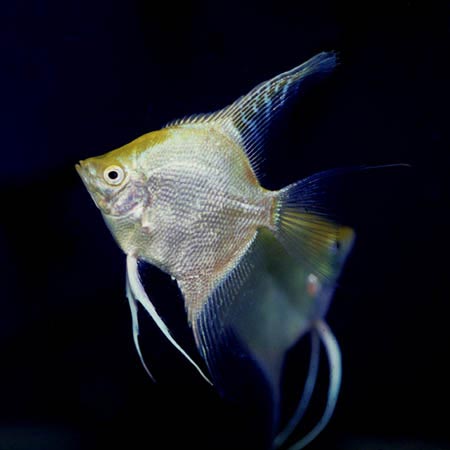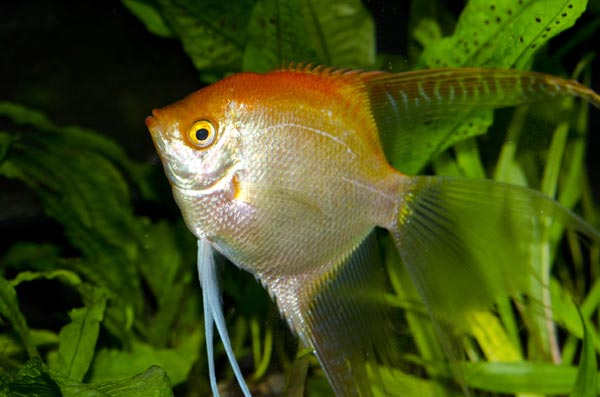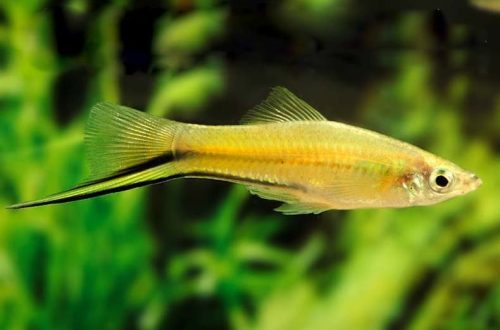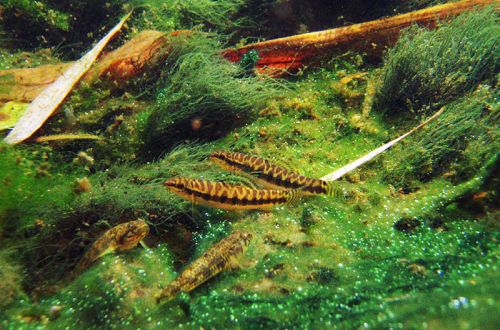
Angelfish (Scalare)
The angelfish, scientific name Pterophyllum scalare, belongs to the Cichlidae family. An elegant and beautiful fish with an unusual body shape that distinguishes it from other species. Such bizarre outlines are also reflected in the scientific name, which can be freely translated from Latin as “Winged Leaf”.

The fish is widely used in the aquarium hobby. It contains both novice amateurs and professionals. At present, it is difficult to find specimens similar to their wild relatives, mainly breeding forms are on sale, which differ in the most diverse colors.
Requirements and conditions:
- The volume of the aquarium – from 120 liters.
- Temperature – 24-28°C
- Value pH — 6.0–7.0
- Water hardness – soft (5-10dH)
- Substrate type – any
- Lighting – subdued
- Brackish water – no
- Water movement is weak
- Size is about 15 cm.
- Meals – any combination with a high protein content
- Life expectancy – up to 15 years.
Contents
Habitat
The angelfish was first discovered by European explorers in 1823 while studying the flora and fauna of South America. It is found in the central basin of the Amazon River and its tributaries in the territory of modern Brazil, Peru, eastern Ecuador. It occurs in slowly flowing backwaters, swamps, flooded river valleys with dense vegetation. They feed on small fish and invertebrates.
Description

A characteristic feature is a high body strongly laterally compressed with long anal and dorsal fins, creating a diamond-shaped outline. The pectoral fins are long, filiform. Since this species belongs to artificially bred breeding forms, therefore, the scalar has a variety of colors, which varies from a single color to a combination of several colors.
Differences between types of angelfish
 Distinctive features of the three types of angelfish on the example of the shape of the head
Distinctive features of the three types of angelfish on the example of the shape of the head
Food
Accepts all types of dry, frozen and live food. Food should be varied with the obligatory content of high-protein foods (bloodworm, mosquito larvae, etc.) and herbal supplements. On sale there are specialized feeds intended for Angelfish. They combine all the necessary trace elements and sublimated protein products. Feed two to three times a day, all uneaten leftovers should be removed to prevent water retention and overeating.
Maintenance and care
Fish are relatively unpretentious, provided that the water meets the required parameters and is updated weekly by 15–20%. The recommended equipment consists of a filter, an aerator, a heater and a dimmed lighting system. Since the fish comes from reservoirs with a weak current, the movement of water in the aquarium should be minimal.
The design welcomes dense thickets of plants, located in groups around the perimeter of the tank, so that the central part remains free for swimming. As shelters, wooden objects are desirable, such as snags, branches, roots, etc. Any substrate, in this case it is selected from the needs of plants rather than fish.
Social behavior
Quite an aggressive species, moreover, it becomes territorial during spawning. Not recommended for fish that are smaller or equal in size. Only large peace-loving fish can be considered as neighbors within a large aquarium of at least 300 liters. Species aquarium preferred.
Breeding / Reproduction
Due to the difficulty in determining gender, the best solution is to purchase several fish, for example, 4-8 individuals. Angelfish begin to breed at the age of 6-12 months, depending on external conditions.
The stimulus for spawning is a change in water parameters, the pH value is set around 6.5 (slightly acidic), and dH is about 5 (soft). The diet is shifting towards protein foods. After a while, the fish form pairs and begin to stay in a separate area of the aquarium, create their own territory. Sometimes you can hear the sound, clicks, they are made by males during mating.
Females lay about 1000 eggs on plant leaves, which are then fertilized. Parents remain to guard their offspring and attack anyone who approaches their territory. However, as a result of numerous selections, parental instincts can be lost, in which case the offspring are threatened with being eaten by their own parents, so plants with eggs will have to be planted in a separate spawning tank with identical conditions.
The emerging fry should be fed with specialized micro food.
Fish diseases
Fish are susceptible to various diseases, especially ichthyophthyriasis. Health problems are manifested when the quality of water changes or deteriorates, it does not meet the required parameters. Read more about symptoms and treatments in the Aquarium Fish Diseases section.
Features
- Not the friendliest species to other fish
- Requires quality food, rich in protein





